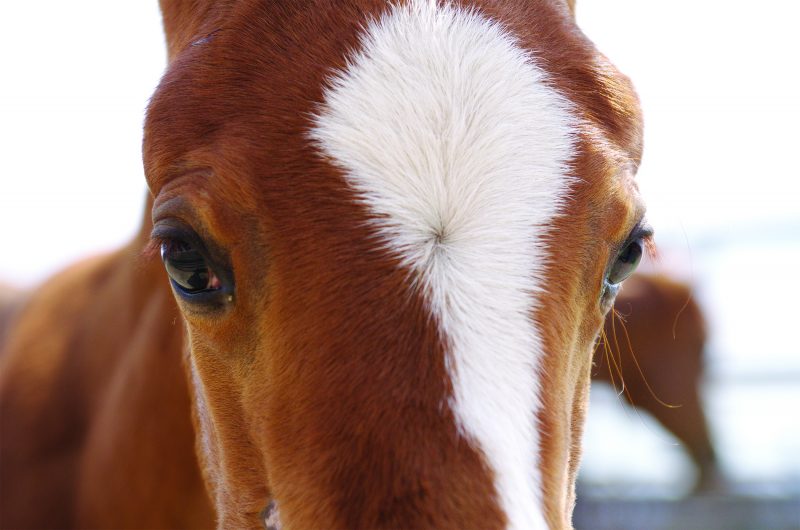Where the L Matters Most
Written by Heather Bode • Photography by Jinny Jandron
“We humans owe these creatures of God that perform at our bidding, our greatest respect.”
This eloquent statement, a salute to the horses they breed and race, graces the indoor arena owned by Gary and Dee Hoovestal of Helena. The image conjured by the words suggests a rider bowing to his steed- an appropriate gesture for all who know and love everything equine.
GETTING STARTED
Gary Hoovestal hails from Sanders, Montana, between Hysham and Forsyth, where his father owned Hoovestal’s Country Store. While his dad assisted customers, Gary was out back building and practicing in his own rodeo arena. “My dad always had horses and we had a few cows, too, on rented land on Sarpy Creek,” he says. By the time he was 9 or 10 he owned his first horse and still has the boots and spurs to prove it. “I broke horses when I was young and did rough stock and roped calves in rodeo.”
In 1956, as a junior in high school, he competed in the three rough stock events at the National High School Rodeo in Reno, Nevada, where he placed second in bull riding. “My dad always liked race horses. He’d go watch them at the fairs but he never owned any. Once we got established in our construction business, I bought him a race horse and ‘the floodgates were opened,’” he laughs.
BREEDING BASICS
Breeding race horses is a tricky business. It’s also pricey. “There are multiple things you look at when you breed. We have some average broodmares; well, maybe a few that are top broodmares. But in the breeding process, we select the best stallions,” says Hoovestal. With semen costs ranging anywhere from $5,000 up to $50,000, owners consider things like niches-mix (does this stallion have a history of producing well with this mare?), conformation, racing success and pedigree. Among other things, good conformation means a straight anatomical structure from hoof to shoulder. Pedigree is exceedingly important. Hoovestal adds, “We try to breed to horses that have had great success at the track. We have bred to 40 of the top 50 sires- calculated by their progeny’s money winnings.”
Once the semen arrives and the brood mare is ready, horse manager Missy Quigley takes over. She artificially inseminates the mares and also takes charge of the day to day needs of the mares. When a mare is close to foaling, the mare is watched via monitors. “We can access the monitors online. So when we’re watching in the middle of the night, we’re at home and comfortable. A mare’s labor is only about 20 minutes. Usually, I don’t have to help them. Sometimes, yes, I help,” she says.
The birth of a new baby pulls at the heart strings of every family. This horse family is no different. Out in the barn, Dee Hoovestal calls to the newest addition, “Come here, baby girl. Hi, honey!” The foal nuzzles against her hand.
The naming of the foals is a playfully touchy subject. “We all put our ideas for names in, but Gary always picks his own out. He does a good job, but once in a while, I say ‘NO!’” claims Dee.
Missy Quigley says, “The horses all have different personalities. They’re just like people. You have the quiet gentle ones, the naughty ones. I don’t have a favorite.”
“Oh, you do! You have a favorite,” interject Gary and Dee simultaneously. Turns out, Missy raised a filly named Cupid’s Last Fury whose mother died giving birth.
So what about disciplining an unruly bunch of the foals? Quigley explains, “It’s no different than disciplining a child. It’s mostly psychological. A horse is a prey animal whose first instinct is flight. Their second instinct is fight. You have to give them an opening to show that it’s ok so they don’t run away from you. You have to earn their trust.”
“Breeding is not a science. It’s more of an art. One thing you can’t measure is a horse’s heart: his willingness to run and give it his all. That is probably more important than anything else,” concludes Gary Hoovestal, “and there’s only one way to find out…send them to race at the track.”
RACE TO THE FINISH
Quarter horse racing has been popular in America since colonial times. A basic race is a quarter mile (440 yards) on a straight track of groomed dirt. Today, up to 10 horses are released from a starting gate and photo finishes abound.
“The best way to build your reputation in this industry is to win races,” says Hoovestal. “What are the odds of winning? Slim. Even the very best trainers only win one out of three. It’s just like the lottery: you can buy more tickets and increase your odds or you can buy one ticket and hope you win it. But at the premier racetracks where we run, Ruidoso, New Mexico and Los Alamitos, California, it’s hard to win.”
Once the horses approach two years old, the process of “breaking” begins. “After they are broke, we have traditionally sent them to trainer Bret Vickery in St. George, Utah,” says Hoovestal. Vickery, an accomplished trainer with an All-American Futurity winner on his resume’, will give them at least 150 days of training before their first race. They will then be able to enter a maiden race.
THE X FACTOR
Those who breed and race horses are well aware of the X Factor. This refers to the mitochondrial X chromosome passed on to the foal by its mother. The mare will always pass on one X chromosome, but which one (she has two) is passed on becomes extremely important. “The X Factor is the ‘passing on of the large heart’ factor. A normal horse’s heart weighs 10-12 pounds. Secretariat’s heart weighed 22 pounds. That’s why he was so good,” explains Hoovestal. If you’d like to catch a glimpse of Secretariat’s gene pool, two of his descendants: Mr. Leading Sixes and A Legacy to Fly still gallop outside of Helena.
As we watch the Rio Olympic games, quarter horse trainers will be gearing up for the big race: the two-million-dollar purse All-American Futurity Race held at Ruidoso Downs in New Mexico over Labor Day weekend. Hoovestal has never won that race. So why does he stick with it? “Hope springs eternal,” he says with a chuckle. But, in his heart, he espouses a life motto best summed up by the words of a stanza from a song he penned and recorded:
“In the race to the finish line The tortoise sometimes whips the hare When you’re down and out, there’s nothing more powerful than prayer Whatever your thoughts are is the way your life will spin I’ve found out in this life: You don’t have to run the fastest to win.”
NOT JUST HORSING AROUND
According to the American Quarter Horse Association’s list of Top 10 States by horse population, Montana ranks sixth with a total of 87,052. Not surprising, since a quarter horse’s agility and musculature generally make it a stand-out ranch, rodeo, or race horse.
Here are some other key facts you should know:
• All horses automatically turn a year older each January 1st. So horses born anytime during 2016 will become a one-year-old on January 1st, 2017.
• Quarter horses achieve their top speed at one quarter of a mile.
• What’s the difference between a quarter horse and a thoroughbred? “It’s like the difference between a sprinter and a miler in track,” says Hoovestal. D. Wayne Lucas, an all-time leading thoroughbred trainer, said, “A thoroughbred is just a big quarter horse.”
• Besides claiming descendants of thoroughbreds Secretariat and Seattle Slew, Hooves & Stalls also has descendants by Tres Seis, the sire of Ochoa- the highest earning quarter horse in history ($2,781,365).

